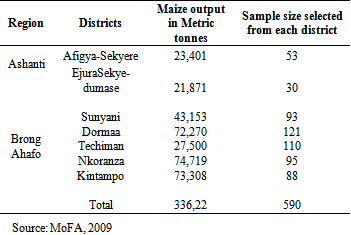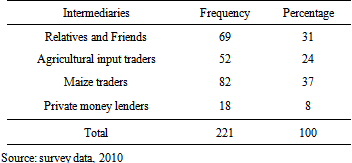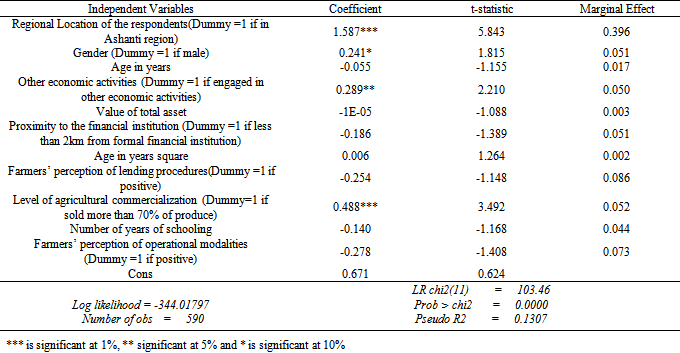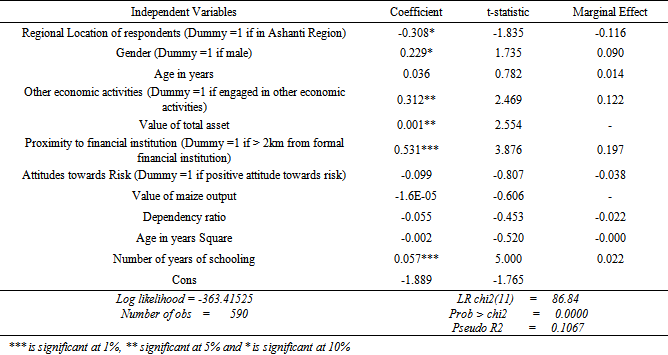-
Paper Information
- Next Paper
- Previous Paper
- Paper Submission
-
Journal Information
- About This Journal
- Editorial Board
- Current Issue
- Archive
- Author Guidelines
- Contact Us
International Journal of Agriculture and Forestry
p-ISSN: 2165-882X e-ISSN: 2165-8846
2012; 2(3): 105-112
doi: 10.5923/j.ijaf.20120203.05
Substitutes or Complements?: Formal and Informal Credit Demand by Maize Farmers in Ashanti and Brong Ahafo Regions of Ghana
Dadson Awunyo-Vitor 1, Vincent Abankwah 2
1Department of Agricultural Economics, Agribusiness and Extension, Kwame Nkrumah University of Science and Technology, Kumasi, Ghana
2Department of Agricultural Economics and Extension Education, University of Education, Winneba, Ghana
Correspondence to: Vincent Abankwah , Department of Agricultural Economics and Extension Education, University of Education, Winneba, Ghana.
| Email: |  |
Copyright © 2012 Scientific & Academic Publishing. All Rights Reserved.
This study examines credit demand by maize farmers and analyses factors influencing their use of informal and formal credits. The analysis is based on data collected from a survey of 590 maize farmers in seven districts of Ashanti and Brong Ahafo Regions of Ghana during May-July 2010. Descriptive statistics, probit and bivariate probit models were used to analyse the data. The study revealed informal credit sources for maize farmers as relatives and friends, traders and private money lenders. Maize traders are major players in the informal credit market followed by agricultural input sellers. Among the formal sources rural banks are the most prominent. Regional location, Gender, engagement in other economic activities and the level of agricultural commercialisation were observed to be factors that influence farmers’ demand for informal credit. In addition to these factors, farmer years of education and proximity to financial institution influence demand for formal credit. The result of the bivariate probit suggests that formal and informal credits are not necessarily perfect substitutes but they complement each other to provide credit needs of farmers in maize production.
Keywords: Maize Farmers, Informal Credit, Formal Credit, Probit, Bivariate Probit
Article Outline
1. Introduction
- The rural financial market in developing countries is composed of formal, semi-formal and informal financial institution (Hussain and Demaine 1992; Steel and Andah 2005). Ghate (1992) defined formal financial services providers as registered companies that are licensed to offer financial services by Central Monetary Authority. He asserted that these institutions are largely urban –based in terms of distribution of branches and the concentration of deposit and lending activities. According to Kashuliza et al. (1998) informal financial services refers to all transaction, loans and deposits that take place outside the regulated monetary system this include activities of intermediaries such as relatives and friends, traders, money lenders. Semi-formal institutors are described by Steel and Andah (2005) as institutions which are registered to provide financial services and are not controlled by central monetary authority. Khandker and Faruqee (2003) noted that informal credit is largely used for consumption and it’s not large enough to spur investment and growth. ISSER, 2008 has, therefore reiterated the importance of formal credit to accelerate the development of the priority areas including industries and agriculture through increased productivity in the agricultural sector. The central monetary authority (Bank of Ghana) has adopted a number of policies, which aimed at increasing formal intermediation in order to increase farmers’ access to formal credit (Ekumah and Essel, 2001). These include interest rate control and credit ceiling. This followed from the perception that low interest rates would induce investment, which in turn would increase output and employment and subsequently, lead to higher savings (Aryeetey and Hyuha, 1991). However, these policies rather led to a distortion of the markets.Formal financial institutions have increased in numbers and capitalisation. Non-Bank financial institution have emerged especially savings and Loans Companies (BOG, 2007). Despite these developments, a study on the progress of implementation of Ghana Poverty Reduction Strategy II (GPRS II) revealed that, large proportion of the rural household tend to demand informal credit. According to Asiedu-Mante (2005) and Steiner (2008) the formal financial institutions are unable to satisfy credit needs of rural folks, thus they tend to use informal credit which are often unsatisfactory, as they carry high interest rate. Aryetey (2008) also noted that despite the development in the formal financial sector informal financial services is still active.The aim of this study is to identify actors within the financial market in the Ashanti and Brong Ahafo regions of Ghana and factors influencing maize farmers’ demand for formal and informal credit and evaluate if their demand for these credit forms are complement or substitute.
2. Materials and Methods
Data Sampling Method
- Multistage sampling was conducted to select 2 regions, 7 districts and 590 farmers for the study. Selection of the regions and districts was guided by the level of agricultural activities and the level of maize production using official statistics from Ministry of Food and Agriculture, MoFA (2009). In Ashanti Region, districts whose maize production output in 2008 exceeded 20,000 metric tonnes were 2 which were selected while in Brong Ahafo Region, the 5 districts which had a minimum of 27,000 metric tonnes each of maize output in 2008 were selected for the study. Table 1 indicates selected districts, level of maize production and number of farmers sampled from each district in the two selected regions. A third stage sampling involved identifying and listing of maize farmers in the operational area. Selection of respondents was guided by their involvement in maize production. A total size of 590 maize farmers from the study area was sampled for the study.
|
Analytical Framework
- Data analysis followed a two-prong approach by making use of both qualitative and quantitative techniques. For the qualitative analysis, descriptive statistics such as percentages, and frequencies were used. Descriptive analysis was undertaken to identify and list all sources from which maize farmers seek financial services. Quantitative analysis used by Okurunt et al. (2004) and Mohieldin and Wright (2000) was adopted and modified to evaluate factors that influence maize farmers’ demand for formal and informal credit. A decision by respondents to demand credit (informal or formal) is assumed to be influenced by the individual and household characteristics as well as institutional factors. Let represent farmers’ decision to demand credit by a latent variable (Yi). This depends on a vector of explanatory variables (Xi) include individual and household characteristics as well as institutional factors. This leads to qualitative response model which can be presented as:
 | (1) |
 There are several methods that can be used to analyse data involving binary outcomes. Linear Probability Model (LPM), probit and logit models can be used to analyse household’s qualitative response or which give rise to binary choice models. If the independent variables are normally distributed the discriminant analysis estimate which follows Ordinary Least Square (OLS) is the true Maximum Likelihood Estimate (MLE) and therefore asymptotically more efficient than the probit and logit models which require Maximum Likelihood method. However, if the independent variable is not normally distributed the discriminant analysis estimate is not consistent, whereas the probit and logit MLE are consistent and therefore more robust (Maddala, 1983; Amemiya, 1981; Cameron and Travedi, 2005).The LPM can be used to analyse binary models such as the one under consideration. Though, Pindyck and Rubinfeld (1981), Amemiya (1981) and Gujarati (1988) have noted that LPM can be used to analyse binary models such as the one under consideration it has serious defect in that, the estimated probability values can lie outside the normal 0-1 range. Hence probit and logit models are advantageous over LPM since the probability values are bound between 0 and 1. Due to the above shortcomings of the OLS and LPM, in the analysis of studies involving qualitative choices, probit model is selected for the analysis of factors influencing demand for creditIn order to assess more formally if informal and formal credits are substitutes or compliments we followed Mohieldin and Wright (2000) by using bivariate probit model, with the following econometric specifications;
There are several methods that can be used to analyse data involving binary outcomes. Linear Probability Model (LPM), probit and logit models can be used to analyse household’s qualitative response or which give rise to binary choice models. If the independent variables are normally distributed the discriminant analysis estimate which follows Ordinary Least Square (OLS) is the true Maximum Likelihood Estimate (MLE) and therefore asymptotically more efficient than the probit and logit models which require Maximum Likelihood method. However, if the independent variable is not normally distributed the discriminant analysis estimate is not consistent, whereas the probit and logit MLE are consistent and therefore more robust (Maddala, 1983; Amemiya, 1981; Cameron and Travedi, 2005).The LPM can be used to analyse binary models such as the one under consideration. Though, Pindyck and Rubinfeld (1981), Amemiya (1981) and Gujarati (1988) have noted that LPM can be used to analyse binary models such as the one under consideration it has serious defect in that, the estimated probability values can lie outside the normal 0-1 range. Hence probit and logit models are advantageous over LPM since the probability values are bound between 0 and 1. Due to the above shortcomings of the OLS and LPM, in the analysis of studies involving qualitative choices, probit model is selected for the analysis of factors influencing demand for creditIn order to assess more formally if informal and formal credits are substitutes or compliments we followed Mohieldin and Wright (2000) by using bivariate probit model, with the following econometric specifications; | (2) |
 | (3) |
 | (4) |
 = propensity of a farmer to demand or use formal credit y1i = observed farmers who demand or use formal credit
= propensity of a farmer to demand or use formal credit y1i = observed farmers who demand or use formal credit  = Propensity of a farmer to demand or use informal credit y2i = observed farmers who demand or use informal credit x1i and x2i= list of explanatory variables with
= Propensity of a farmer to demand or use informal credit y2i = observed farmers who demand or use informal credit x1i and x2i= list of explanatory variables with  and
and  being their associated parameter vectors; and ε1i and ε2i= random error terms that are jointly bivariate normal (BVN).In this case each farmer is assumed to possess a propensity to demand formal credit (
being their associated parameter vectors; and ε1i and ε2i= random error terms that are jointly bivariate normal (BVN).In this case each farmer is assumed to possess a propensity to demand formal credit ( ) and although this is not directly observable, when the propensity becomes positive (ie greater than zero) then the farmer is observed to demand formal credit. This is identical to the standard latent variable approach for probit model. However, in the bivariate probit model framework, the farmer is assumed to possess a propensity to demand informal credit (
) and although this is not directly observable, when the propensity becomes positive (ie greater than zero) then the farmer is observed to demand formal credit. This is identical to the standard latent variable approach for probit model. However, in the bivariate probit model framework, the farmer is assumed to possess a propensity to demand informal credit ( ), which again is observed if the propensity is positive. It is possible that the propensity to demand formal and informal credit may not be independent; therefore, we allow the random error of the informal credit and the formal credit demand equations to be correlated (with correlation coefficient)
), which again is observed if the propensity is positive. It is possible that the propensity to demand formal and informal credit may not be independent; therefore, we allow the random error of the informal credit and the formal credit demand equations to be correlated (with correlation coefficient)3. Results and Discussion
- Informal credit source There are four major intermediaries operating in the informal financial market segment as is evident in Table 2. These are relatives and friends; agricultural input traders; maize traders, and private money lenders. Traders are the most important source of informal credit, about 37% and 24% of the farmers demand credit from maize traders and input traders respectively. Focus group discussion revealed that some of the traders interlink their credit with supply of input or purchase of maize.
|
|
|
|
|
4. Conclusions and Recommendation
- The study revealed informal credit sources for maize farmers as relatives and friends, traders and private money lenders. Maize traders are major players in the informal credit market followed by agricultural input sellers. The prominence of traders as source of informal credit is due to the fact that they interlink credit with purchase of maize and sale of inputs. Among the formal sources rural banks are the most important credit providers. The popularity and use of rural bank has been attributed to the large networked branches which enhance farmers’ proximity and access to formal credit. Regional location, Gender, engagement in other economic activities and the level of agricultural commercialisation were observed to be factors that influence farmers’ demand for informal credit. In addition to these factors, farmer years of education and proximity to financial institution influence demand for formal credit. The result of the bivariate probit suggests that formal and informal credits are not necessarily perfect substitutes but they complement each other to provide credit needs of farmers in maize production. Increasing the branch network of the formal credit institutions especially rural banks will improve access to and enhance farmer demand for formal credit. Encouraging farmers to undertake alternative livelihood activities will enhance their loan repayment capacity that empowers them to benefit from both formal and informal credit sources. Education is an important variable influencing demand for formal credit, hence farmers need to be educated on the credit policies and requirements of the formal financial institutions. Given that informal credit is a complement to formal credit effort should be made to build capacity of intermediaries especially traders who are major players within the informal credit market.
 Abstract
Abstract Reference
Reference Full-Text PDF
Full-Text PDF Full-Text HTML
Full-Text HTML




